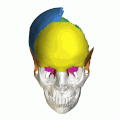Neurocranium
Neurocranium is the upper and back part of the skull, which forms a protective case around the brain. In humans, it is made up of the frontal, parietal, occipital, temporal, sphenoid, and ethmoid bones.
Structure
The neurocranium is divided into two parts: the Membranous neurocranium and the Cartilaginous neurocranium. The membranous neurocranium is formed from flat bones and includes the frontal, parietal, squamous part of the temporal, and the upper part of the occipital bones. The cartilaginous neurocranium is formed from the ethmoid, sphenoid, petrous and mastoid parts of the temporal, and the lower part of the occipital bones.
Development
The neurocranium forms during the embryonic stage from the mesoderm layer of the embryo. The development of the neurocranium involves the process of ossification, where the cartilaginous neurocranium is replaced by bone.
Function
The primary function of the neurocranium is to protect the brain and its associated sensory organs including the eye, ear, and nose. It also provides attachment for muscles that assist in head and neck movement.
Clinical significance
Conditions that affect the neurocranium can have serious implications, as they can impact the brain and other structures within the skull. These conditions include craniosynostosis, which is the premature fusion of the skull bones, and cranial fractures, which are breaks in the neurocranium.
See also
References
Transform your life with W8MD's budget GLP-1 injections from $125.
W8MD offers a medical weight loss program to lose weight in Philadelphia. Our physician-supervised medical weight loss provides:
- Most insurances accepted or discounted self-pay rates. We will obtain insurance prior authorizations if needed.
- Generic GLP1 weight loss injections from $125 for the starting dose.
- Also offer prescription weight loss medications including Phentermine, Qsymia, Diethylpropion, Contrave etc.
NYC weight loss doctor appointments
Start your NYC weight loss journey today at our NYC medical weight loss and Philadelphia medical weight loss clinics.
- Call 718-946-5500 to lose weight in NYC or for medical weight loss in Philadelphia 215-676-2334.
- Tags:NYC medical weight loss, Philadelphia lose weight Zepbound NYC, Budget GLP1 weight loss injections, Wegovy Philadelphia, Wegovy NYC, Philadelphia medical weight loss, Brookly weight loss and Wegovy NYC
|
WikiMD's Wellness Encyclopedia |
| Let Food Be Thy Medicine Medicine Thy Food - Hippocrates |
Medical Disclaimer: WikiMD is not a substitute for professional medical advice. The information on WikiMD is provided as an information resource only, may be incorrect, outdated or misleading, and is not to be used or relied on for any diagnostic or treatment purposes. Please consult your health care provider before making any healthcare decisions or for guidance about a specific medical condition. WikiMD expressly disclaims responsibility, and shall have no liability, for any damages, loss, injury, or liability whatsoever suffered as a result of your reliance on the information contained in this site. By visiting this site you agree to the foregoing terms and conditions, which may from time to time be changed or supplemented by WikiMD. If you do not agree to the foregoing terms and conditions, you should not enter or use this site. See full disclaimer.
Credits:Most images are courtesy of Wikimedia commons, and templates, categories Wikipedia, licensed under CC BY SA or similar.
Contributors: Prab R. Tumpati, MD






